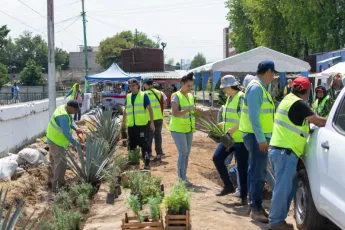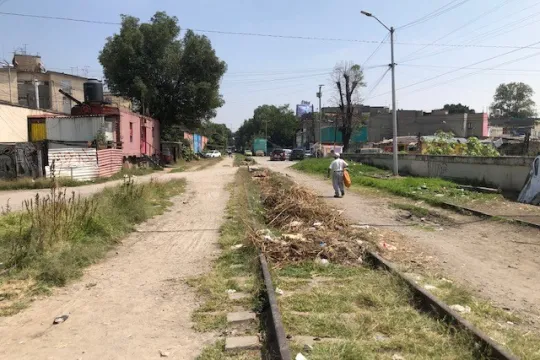
Installation of a rain garden with community participation on the banks of the Hondo River, Naucalpan. © Héctor Ríos
The Naucalpan Urban Lab is focused on transforming a priority area, chosen by its members and known as the transformation polygon, that faces significant challenges, such as the presence of abandoned industrial zones undergoing reconversion, commercial and service areas, lack of public spaces and high marginalization and crime rates. The river, Rio Hondo, runs through this area, a polluted body of water that receives wastewater and garbage, exacerbating environmental and social problems.
Three low-cost, easy-to-implement experimental projects were implemented to mitigate these problems and adapt to climate change. The actions were conceived as Nature-based Solutions (NbS), with the implementation of green infrastructure and community co-creation in two key areas: the square, Plaza Revolución, and the river banks of Rio Hondo. The participation of local authorities and Citizen Participation Councils (COPACI) and the collaboration of academia and environmental groups was essential.
Rain garden on the river banks of Rio Hondo
The first intervention took place on the river banks of Rio Hondo, near the old railway tracks, where informal houses have been built in railway cars and a high level of insecurity is observed. A rain garden was created with endemic species, and a community mural was painted. The local community, especially mothers and fathers from a nearby school, actively participated in the reforestation and mural painting activities, improving the perception of security and increasing interest in environmental issues, according to data from a perception survey applied before, during and after the intervention.
Intervention in the square, Plaza Revolución
Two interventions were carried out in the square, Plaza Revolución, to diversify its use, increase people’s permanence and improve thermal comfort. Covered benches were installed to provide shade, reducing temperatures by up to 6°C and adding plants and flowers to enhance the space. Currently, this space is a paved area with little street furniture and the main generator of the heat island effect. A skating area was also delimited, and a green point was built to collect recyclable materials, batteries and medicines, accompanied by capacity-building sessions on waste management for the community.
Community participation and results
The interventions demonstrated the importance of improving and recovering public spaces with the active participation of the community. The capacity-building and co-creation sessions ensured the effectiveness of the actions and promoted community engagement. This participatory approach is essential to achieve more resilient, sustainable and cohesive communities.

